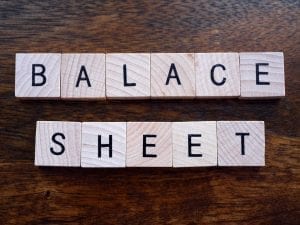Balance Sheet Basics
As we’ve discussed in previous articles, a balance sheet is one of the most basic financial statements prepared by bookkeepers. Bookkeepers produce multiple financial statements, but the balance sheet is arguably the most important. Simply put, a balance sheet gives a snapshot of the overall financial condition of a company at a given point in time; it is an overview of the company’s entire financial health, not just one aspect of its financial health. This separates balance sheets from other financial statements which give a more limited sense of a company’s financial health.

In this post, we will go over the most common things which are found on a balance sheet. There are three main categories – assets, liabilities, and equity – which appear on literally every balance sheet. On top of these three main categories, there is a number of other common items which show up often on balance sheets but may also be left out depending on the situation. Given the importance of balance sheets, all business owners should take the time to learn how to read these documents. After reading this post, you’ll have the tools to decipher the most basic parts of a balance sheet. If you’d like more information, don’t hesitate to reach out to us. The team of tax professionals and bookkeeping professionals at Boxelder Consulting are available to help answer your questions at any time. Reach out to us by calling 303-317-6111.
The Three Main Categories on a Balance Sheet
Balance sheets give a clear picture of the financial health of a company at a certain point in time. To do this, balance sheets contain three main categories of information which combine together to create this picture. These three categories are assets, liabilities, and equity. Assets represent all the property currently possessed by the company. This includes not just items owned by the company but also leased or loaned items. Liabilities represent all the financial debts and obligations of the company at a given point in time. The equity represents the difference between assets and liabilities, or the “net assets” owned by the company shareholders. If you think about this for a moment, it should become intuitive. If a company owns property valued at $100,000, but has liabilities which equal $75,000, then the company shareholders would really only “own” $25,000. And this true “ownership” is represented by equity.
The Other Items Found Within These Three Categories
As mentioned, within each of the three main categories found on a balance sheet you will see many different items. Depending on the situation, certain of these more specific items may be left out. Within the asset category, items are listed according to their level of liquidity. This means that the more easily an asset can be converted to cash, the higher up within the asset category it will be listed. The following asset items are commonly found on balance sheets: cash, cash equivalents, accounts receivables, inventory, sellable securities (such as stocks and bonds), prepaid expenses, long-term investments (such as securities which cannot be readily sold), fixed assets (i.e. land, machinery, etc.), and intangible personal property. Again, depending on the circumstances, some of these items may not appear at all.
Within the liabilities category, items are divided into short-term liabilities and long-term liabilities. Short-term liabilities are generally those which are due within one year, and long-term liabilities are those due beyond one year. Common short-term items include the following: bank debt, interest payable, rent, taxes of various kinds, utilities, wages payable, dividends payable, and unearned premiums. Common long-term items include: interest and principal on bonds, pension funds, and any deferred tax liabilities. When assets and liabilities combine together, they will balance out to yield company equity. And the equity category can be represented by various items. Within the equity category, you may see the following items which represent the net assets owned by the company shareholders: retained earnings (i.e. assets retained by the company to fund various purposes), treasury stock (unissued stock which is used for various purposes), preferred stock and common stock. Essentially, whatever remains after assets and liabilities balance out will represent the equity of the company, but that equity can be shown more precisely with these specific items.
Contact Boxelder Consulting for More Information
As usual, this is quite a lot of information to take in. Balance sheets often contain a lot of information, which makes sense because these documents are meant to provide a very detailed picture of a company’s general financial condition. But this means that business owners often need to employ outside help to produce and interpret these documents. If you need a bookkeeper for this type of service, don’t hesitate to contact Boxelder Consulting right away. Also contact Boxelder Consulting if you have further questions regarding the mechanics of balance sheets. Call us today at 303-317-6111.
